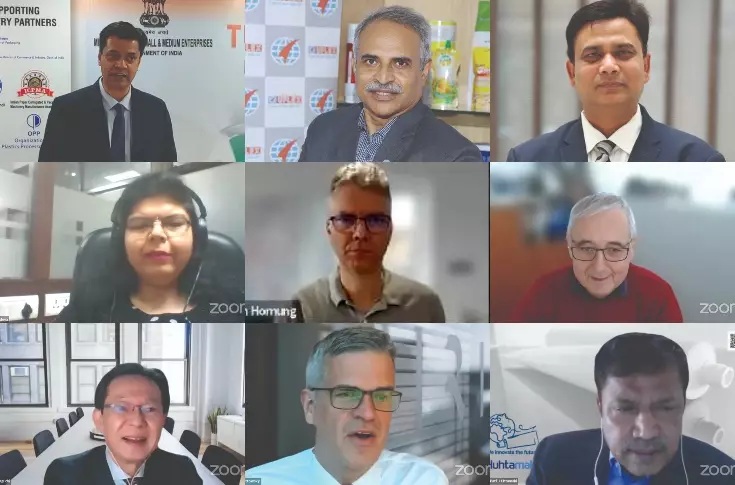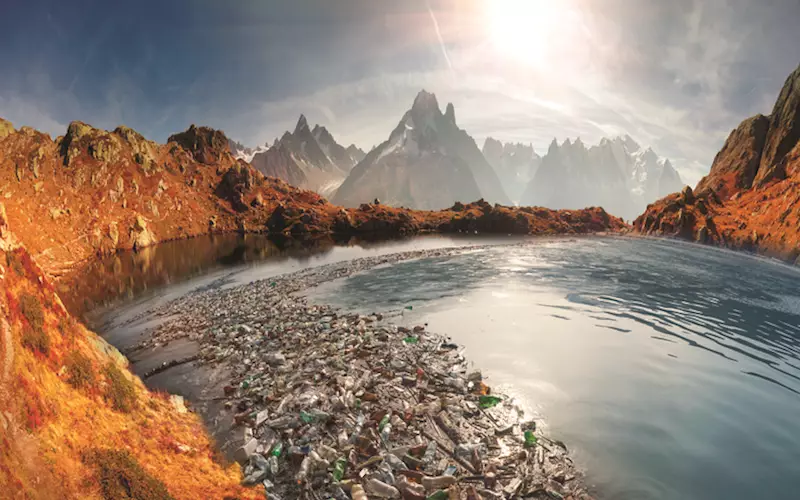Brands talk innovations at flexible packaging summit
The Global Summit on Flexible Packaging, organised by PHDCCI and the Ministry of MSME, saw industry leaders addressing the challenges faced by the flexible packaging sector. Aultrin Vijay reports
25 May 2022 | By Aultrin Vijay
The timing was apt. The Union Environment Minister Bhupendra Yadav said on 28 February, “We've issued a notification to ban single-use plastic and a resolution for the same will be passed.” From Chennai to Dehradun, civic bodies are imposing strict action on single-use plastics (SUP). Even as the Global Summit on Flexible Packaging organised by the Ministry of MSME, in association with PHD Chamber of Commerce and Industry (PHDCCI) was in session on 23-24 February 2022, the Greater Chennai Corporation told the Madras High Court that its officials had seized 20 tonnes of banned single-use plastics between 19 August 2021 and 18 March 2022. The authorities collected a total of Rs 36.5 lakh in fines during this period from those violating the single-use plastic ban. And this is what brand owners and packaging experts had gathered to discuss.
What happens next? What with most SUP items being banned from 1 July 2022 as per the 12 August 2021 notification of the Ministry of Environment, Forest and Climate Change?
Ajit Gupta, co-chair, of the PHDCCI Packaging Committee and director of Ajit Industries kicked off the summit. He said, “Since the last few years, we’re noticing that flexible packaging is rapidly replacing traditional packaging such as glass jars and metal cans mainly due to the multiple benefits such as extended shelf life, cost-effectiveness, lightweight, and less cost of transportation,” he says, adding, “This reduces the cost of production. There is significant growth of flexible packaging across food, beverage, cosmetics and personal care products, household and pharmaceutical products.”
He spoke about how packaging converters who are developing new innovative mono polymer, fully recyclable flexible packaging laminates. “In the case of sustainability, we witness the continued transition from plastic to paper flexible packaging. Plastic provides significant benefits of barrier functionality delivering resistance to gases, moisture, light and aroma where needed. But for certain packaging such as confectionery packs, paper is more suitable, and brands find it suitable in terms of environmental concerns.”

EPR: A boon or bane?
The Indian packaging industry is poised to cross USD 70 billion in volume and continues to grow at a CAGR of 18%, where flexible packaging enjoys the highest share.
“However, the industry is at a crossroads,” says Jeevaraj Pillai, co-chair, PHDCCI Packaging Committee and joint president – packaging and new product development, UFlex. “Although the discussions on sustainability and circular economy have been around for some time, a clear direction is missing. However, guidelines from major FMCG companies and food companies and the recently announced EPR guidelines define the course of action now and propose a clear way forward for every stakeholder of the industry.”
The government of India has notified EPR rules for plastic packaging in India. Producers of these products are responsible to collect the waste they generate. Pillai claimed that EPR encourages the producers and brand owners to work in the direction of reducing plastic waste by recycling, reusing the recycled contents, and the use of biodegradable packaging.
“It is now no longer a matter of choice,” he adds.
Readers of WhatPackaging? should know that a centralised EPR portal for plastic packaging waste has been made operational on a trial basis in India. This will facilitate the Registration of Plastic Waste Processors (PWPs) and EPR Registration for producers, brand-owners, and importers (PIBOs) under the PWM Rules.
Innovations in food-grade packaging
According to a recent report by Exim Bank, the Indian packaging industry is worth more than USD 50.5 billion with a CAGR of 15-18%. “This is a good thing,” says Tanweer Alam, director, of the Indian Institute of Packaging (IIP).
“Flexible packaging, due to its several advantages, is being used in all segments, especially food and pharmaceutical,” Alam says.
He added that the Indian flexible industry is doing very well in terms of sustainability and that India is becoming a hub for biodegradable polymeric material. “During the last three months, we also analysed solutions that could enable recyclable packaging materials to be used for packing food and can be incorporated in the upcoming amendment by FSSAI,” Alam reveals.
He also spoke about how IIP has incorporated topics such as sustainability and recycled flexible packaging in its syllabus. “This will enable students to be well-equipped in the field of sustainability,” he says.
Alam also revealed that IIP is in the process of getting approval from the Ministry of Environment for certifying biodegradable polymeric materials, for which the institute has created a testing facility with the help of UFlex.
Film extrusion technology
Speaking about the circular economy, Christoph Lettowsky, technical director at Germany-based Reifenhauser Blown Film, said that closing the loop has been possible for glass, paper and metals, but for the plastics industry it’s a challenge. He claimed that Reifenhauser did some work on the machine technology side to address this.
During his session, he elaborated on innovations in recyclable film product solutions to produce MDO PE films. “One challenge that we will face in the future is to produce recycled materials. But the bad news is that it will not always be very good, high-quality recyclates. Compared to virgin material, the challenge will be the quality of your material,” Lettowsky explains.
He also said that mono-material packaging, such as BO-PET films, is a very popular packaging solution. “A stand-up pouch usually has a PE sealant film in the inner layer, glued with an adhesive layer to the outer layer, which is usually 12μm BO-PET film. The challenge is that such a package cannot be recycled due to the mix of PE and PET films,” Lettowsky says.
“For the past couple of years, everybody in the sector was focusing on replacing it with PET film. And how can we do that? One way is to stretch PE film in the machine direction, if the film contains 40-50% HDPE, and stretch it 5.5-6 times in the machine direction. The nature of the film changes and creates a film with properties, which allow replacing a 12-micron PET film with 20-, 23- and 25-micron thick stretch film,” he explains.
He elaborated on the solutions offered by Reifenhauser such as the EVO Ultra Stretch films, developed on Reifenhauser’s EVO Ultra Stretch unit.
He also listed out three golden rules of stretching: “1) The warmer the film before the stretching, the less energy is required, 2) The less crystalline the film, the easier is stretching, and 3) The longer the annealing time, the better is the shrinkage behaviour.”
Recycling metal barrier packaging
Germany-based Saperatec is a start-up focused on recycling multi-layer materials from polymers, metals, paper and glass, with 15 staff mainly in R&D and engineering. The major area of activity is in the area of metal barrier flexible packaging materials. The company is on track to commission its first aluminium foil/polymer packaging waste recycling plant this year in eastern Germany.
Once operational, the plant will have an input capacity of up to 30,000 tonnes – starting with Alu-foil laminate waste (post-production) and beverage carton waste (post-consumer) after defibring.
Thorsten Hornung, CEO at Saperatec spoke about the advanced mechanical recycling of multi-material flexible packaging films through composite material delamination, a recycling technology that the company is proud of.
He claimed that the process has been optimised for minimised environmental impact and for food compatibility, so “all the chemicals we're using here are water-based and all the chemicals have a food contact rating”. The company currently focuses on four major types of packaging: traditional aluminium foil barrier pouches, beverage cartons, tube materials, and pharma blister packs.
Speaking about recovering film-grade recycled polymers and aluminium, Hornung says, “It keeps the metallised composite materials away from incineration, achieves more than 91% recycling ratio, with less than 50% CO2 footprint, high quality recycled materials, and low environmental footprint.”
Lightweighting and other takeaways
Meenu Sachdeva, assistant general manager, Ultimate Flexipack spoke about sustainable mono-material and high barrier laminates for food packaging. Sachdeva also mentioned the sustainability benefits of flexible packaging, and the role of packaging in fighting food waste and explored the advantages of PE-based mono-material and the solutions offered by Ultimate Flexipack.
Toshio Yamaguchi, senior counsellor, sales and marketing department at Japan-based Totani Corporation, explained the technology for pouch-making with mono-material recyclable material and highlighted the challenges and solutions for it.
On day two of the summit, Mirslov Hinkov, managing director at Bulgaria-based Mechatronica spoke about the latest technologies in laminates and flexi tubes. Hinkov elaborated on how a reduction in material usage can be achieved by using thinner foils and integrating shoulder/cap. He also revealed how Mechatronica was planning to reduce aluminium usage and opt for pre-and post-consumer recycled materials.
Hinkov says Mechatronica is aiming to reduce material usage and use more recyclable materials, reduce labour costs, and improve efficiency to protect the environment and maintain lower costs.
Vishwanath Patil, senior product development manager – Asia, Global Tube Laminates, Huhtamaki spoke about sustainable development in tubes.
He says, “In Huhtamaki, we are embedding sustainability in everything we do to achieve carbon-neutral production and designing all our products to be recyclable, compostable or reusable by 2030. We would want to have 100% of our products designed to be recyclable, compostable and reusable (in flexible packaging), and source over 80% renewable or recycled raw materials. We aim to consume 100% renewable energy to achieve carbon-neutral production and science-based emission targets.”
He adds, “We believe the value of packaging is higher than its impact on the environment. We aim our packaging materials to be renewable, recyclable, carbon-neutral and smart (integration of track-and-trace).”
Patil highlighted its Blueloop sustainable packaging solution, which is designed to address the issues created by the linear consumption model. Huhtamaki claims that this model will help its customers “reach their sustainability goals by making flexible packaging circular”.
According to Patil, Blueloop design uses a minimum of 90% standard packaging materials (PE and PP). It can be recycled with a yield of more than 70% in an existing recycling process, 90% mono-material usage in final packaging applications, and “can be bio-based and never compete with human food”.
Patil claims that with Blueloop, sorting becomes easier. So, it is circular as well as easier to recycle. The company is now working on solutions having 99% mono materials, either PE or PP, which gives improved recyclability. It will also replace aluminium with other high barrier solutions.
Meanwhile, Venkatesh Rajagopalan, business head – Tube Division, UFlex, elaborated on enhancing aesthetics in flexi tubes.
Rajagopalan says, “Flexitubes from the house of UFlex overcomes the limitations of present conventional tubes both co-extruded and lamitubes by providing unmatched features in terms of aesthetics, barrier properties and anti-counterfeit properties.”
He adds, “Flexitubes is a multilayer structure. We only do reverse printing, so there’s no need for the surface coating for print production. Its decoration layer provides varied options including foil effect and anti-counterfeit options.”
During his presentation, Rajagopalan showcased different types of tubes with different graphic effects and other latest innovations from UFlex. He briefly spoke about sustainability and highlighted its EcoFlex sustainable tube solutions, which include Earthika biodegradable tubes, Kraftika paper-based tubes and Remika recyclable tubes.











 See All
See All